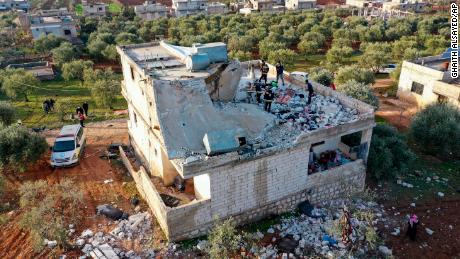
Beirut, Lebanon (CNN)The so-called caliphate has lost its leader again. On the surface, the US commando raid in Syria that left ISIS chief Abu Ibrahim al-Hashimi al-Qurayshi dead may look like a game-changer, but experts warn the resurgence of the group is likely to press on undeterred.
Thanks to the bravery of our troops, this horrible terrorist leader is no more,” declared US President Joe Biden, hours after the end of the operation that targeted Qurayshi in the Syrian rebel enclave of Idlib.
Biden may have hoped for the same fanfare that greeted his predecessors when they took out ISIS founder Abu Bakr al-Baghdadi and al Qaeda leader Osama bin Laden before him. But ISIS experts were quick to throw cold water on claims of a significant blow to the group. Qurayshi is no Baghdadi, and a group that once commanded a piece of territory bigger than the United Kingdom is now a guerrilla insurgency with its leadership scattered.
But the group that delivered genocide, mass execution and oppression has proven that it remains a formidable force. A United Nations report released Friday said the terror group is far from vanquished. In fact, it remains a potent force in Iraq and Syria, with a growing presence in Afghanistan and West Africa, according to the UN analysis.
The report — compiled by UN experts on ISIS and al Qaeda before Qurayshi’s death and covering the last six months of 2021 — said ISIS may still have up to $50 million in its coffers.
Even before his demise, according to the UN experts, ISIS had lost several important members of its senior echelon. And yet the group remains a threat. Instability in both Iraq and Syria “indicate that an eventual ISIL resurgence in the core region cannot be ruled out,” the report concludes, referring to the group by its alternate acronym.
In Iraq, ISIS stages attacks on an almost daily basis. In Lebanon, officials says it has found fertile recruiting ground in the city of Tripoli. And the United Nations says ISIS may still have $50 million in its coffers and up to 10,000 fighters across Syria and Iraq.
Last week ISIS launched its biggest attack in three years when the group’s fighters attempted to free inmates from a prison in northeast Syria. It lost the week-long standoff, and hundreds of ISIS inmates, including children, as well as scores of US-backed Kurdish fighters, died in the fighting.
The uptick in ISIS violence has the region’s security officials on edge, precisely because the picture is murkier than it was in ISIS’ heyday, when the group seized Mosul in 2014. Then, a US-led coalition, as well as Iran-backed Shia armed groups, fought years-long battles that ultimately led ISIS territory to vaporize. Now ISIS is virtually invisible. Its spread is detectable but appears to not have a single source.
For that reason, the US raid — as dazzling as the optics may have been to some — raises more questions than it answers. What was the ISIS leader doing in Idlib, where the group’s ostensible rivals Hay’at Tahrir al Sham, a former al Qaeda affiliate, dominates? How was he able to command cells further afield in Syria and Iraq?
Far from reassuring observers and security officials, the devil in the details of Thursday’s operation seems to confirm what experts have been saying for months: Qurayshi was the head of a snake, but it will require a lot more sophistication and international cooperation to exterminate the pit from which he came.




